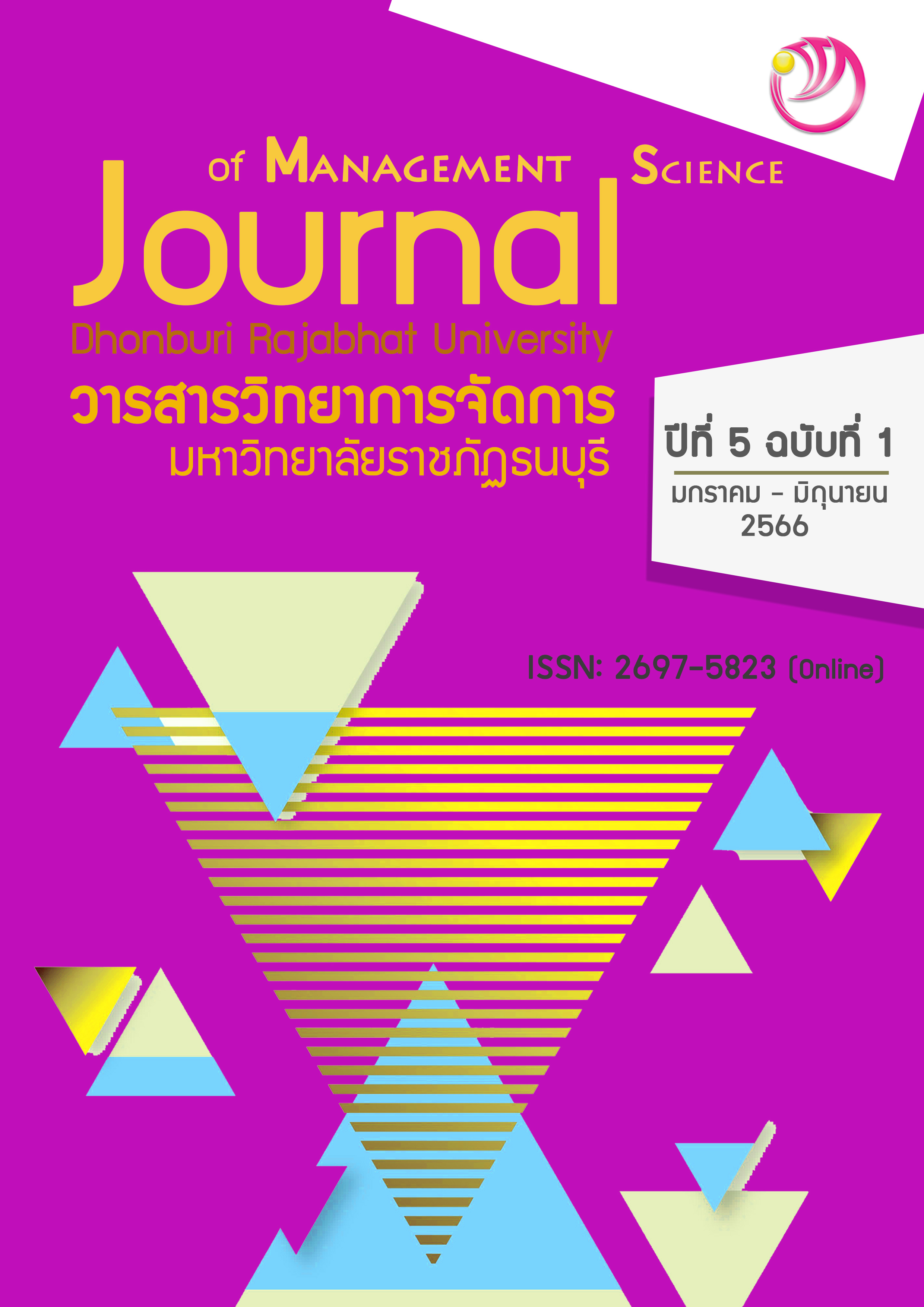Behavior and Decision to Use Restaurant Service at Yayoi Japanese Restaurant: Central Pinklao Branch
Keywords:
Consumer Behavior, Decision to Use Restaurant Service, Japanese RestaurantAbstract
The objectives of this research were 1) to study the behavior of using Japanese restaurant services at Yayoi: Central Pinklao Branch, classified by individual factors and service behavior factors. The samples of 400 consumers visited Yayoi Japanese restaurant: Central Pinklao branch were used in this study. The research instrument that used in the study was questionnaires. Data were analyzed by using frequency, percentage, mean, standard deviation, t-test, and one-way ANOVA. The results showed that consumers who used the restaurant service chose a set menu, used the service between 2:01 PM- 6:00 PM, used the service once a month, and ate with their family members. The average spending per visit was 201-400 baht per person. The results of hypothesis testing accepted that the decision in using the restaurant service was different based on the gender and frequency of visit with the statistical significance level of 0.05. The results of the research can be used as guidelines for restaurant by improving the service according to the gender of the customer, and creating promotions to keep customers coming back to use again.
References
กรุงเทพธุรกิจ. (2565, 15 พฤศกิจกายน). ร้านอาหารญี่ปุ่นโตต่อเนื่องเปิดใหม่ในต่างจังหวัดแซงหน้า กทม. สืบค้นจาก https://www.bangkokbiznews.com/business/977869.
กิตติภพ สงเคราะห์ และสุพรรณี อินทร์แก้ว. (2555). ปัจจัยที่มีผลต่อพฤติกรรมการเข้าใช้บริการร้านอาหารญี่ปุ่นของผู้บริโภคในจังหวัดปทุมธานี. การค้นคว้าอิสระบริหารธุรกิจมหาบัณฑิต วิชาเอกการตลาด. มหาวิทยาลัยเทคโนโลยีราชมงคลธัญบุรี.
กีรติ พรมต๊ะ และพิพัฒน์ เขาทอง. (2556). พฤติกรรมและปัจจัยส่วนประสมทางการตลาดของผู้บริโภคอาหารญี่ปุ่น กรณีศึกษา: ร้านซากุระซูชิในอำเภอหัวหิน จังหวัดประจวบคีรีขันธ์. จุลนิพนธ์บริหารธุรกิจบัณฑิต สาขาการจัดการธุรกิจทั่วไป. มหาวิทยาลัยศิลปากร.
คณะกรรมการบริหารหลักสูตรบริหารธุรกิจมหาบัณฑิต. (2547). การนำแนวคิดและทฤษฎีอ้างอิงในการทำวิทยานิพนธ์ทางธุรกิจ. บัณฑิตวิทยาลัย มหาวิทยาลัยราชภัฏพระนครศรีอยุธยา: พระนครศรีอยุธยา.
จตุพัฒน์ บุตรอำลา. (2557). การศึกษาระดับความสำคัญของปัจจัยส่วนประสมทางการตลาดที่มีผลต่อพฤติกรรมกระบวนการตัดสินใจสมัครใช้บริการ ฟิตเนส เซ็นเตอร์. การค้นคว้าอิสระบริหารธุรกิจมหาบัณฑิต. มหาวิทยาลัยหอการค้าไทย.
นฤชยา กัญหาลัด และสุวลี โล่วิรกรณ์. (2558) การบริโภคอาหารญี่ปุ่นของนักเรียนมัธยมศึกษาตอนปลาย โรงเรียนสาธิตมหาวิทยาลัยขอนแก่น (มอดินแดง) จังหวัดขอนแก่น. วารสารโรงพยาบาลมหาสารคาม, 12(3), 45-59.
ณัฐเกียรติ พุทธจง. (2558). ปัจจัยที่มีผลต่อพฤติกรรมการใช้บริการซ้ำของลูกค้าร้านอาหารญี่ปุ่นประเภทราเมนในห้างสรรพสินค้าฟิวเจอร์พาร์ครังสิต. การค้นคว้าอิสระศิลปศาสตรมหาบัณฑิต. บัณฑิตวิทยาลัย มหาวิทยาลัยกรุงเทพ.
ธัญญ์ธิชา รักชาติ และกิติมา ทามาลี. (2560). ปัจจัยที่มีผลต่อการตัดสินใจของผู้บริโภคในการเลือกใช้บริการร้านอาหารญี่ปุ่นในศูนย์การค้าอยุธยาซิตี้พาร์ค จังหวัดพระนครศรีอยุธยา. วารสารวิจัยราชภัฏกรุงเก่า, 4(1), 1-6.
พรมิตร กุลกาลยืนยง. (2561). พฤติกรรมการบริโภคอาหารไทยและปัจจัยที่ส่งผลต่อความพึงพอใจของผู้บริโภคที่มีต่อร้านอาหารไทยในเขตกรุงเทพมหานคร: ศึกษาเปรียบเทียบผู้บริโภคกลุ่ม Gen-X และ Gen-Y. วารสารวิชาการนวัตกรรมสื่อสารสังคม, 6(1), 66-75.
พวงแก้ว บวรกิจสุธี. (2556). คุณภาพการบริการไลฟ์ สไตล์ และปัจจัยส่วนประสมการตลาดส่งผลต่อการตัดสินใจใช้แอพพลิเคชั่นบนโทรศัพท์มือถือ. การค้นคว้าอิสระบริหารธุรกิจมหาบัณฑิต. มหาวิทยาลัยกรุงเทพ.
ภาวินี กุลเจริญ. (2563). ปัจจัยที่มีอิทธิพลต่อความพึงพอใจในการบริโภคอาหารของผู้บริโภค ร้านยาโยอิสาขาซีคอน บางแค. การค้นคว้าอิสระบริหารธุรกิจมหาบัณฑิต. มหาวิทยาลัยสยาม.
วิลาวัณย์ ฤทธิ์ศิริ. (2559). กระบวนการตัดสินใจซื้ออาหารสำเร็จรูปแช่แข็งของคนวัยทำงานในกรุงเทพมหานคร. การค้นคว้าอิสระบริหารธุรกิจมหาบัณฑิต. มหาวิทยาลัยรามคำแหง.
ศิริวรรณ เสรีรัตน์ และคณะ. (2552). พฤติกรรมผู้บริโภค. กรุงเทพฯ: วิสิทธิ์พัฒนา.
สรรเสริญ สัตถาวร. (2563). อิทธิพลของคุณภาพการบริการ ความคุ้มราคา และอัธยาศัยดีมีไมตรีจิตของพนักงานต่อความพึงพอใจในการใช้บริการร้านอาหารญี่ปุ่น. วารสารบริหารธุรกิจเทคโนโลยีมหานคร, 17(1), 179-197.
เอกณรงค์ วรสีหะ. (2558). นวัตกรรมด้านอาหารกับพฤติกรรมกับการบริโภคอาหารของคนไทยในปัจจุบัน. วารสารดุษฎีบัณฑิตทางสังคมศาสตร์, 5(3), 1-13.
Amidi, A., Darvishmoghaddam, E., Razmfarsa, A., & Othman, R. B. (2022). Impact of five important factors on restaurant performance and hospitality management: An empirical analysis of technological innovation. Future Technology, 1(2), 1-17.
Cochran, W. G. (1977). Sampling techniques (3rd ed.). New York: John Wiley & Sons.
Kotler, P., & Keller, K. L. (2012). Marketing management. London: Pearson Education.
Nakayama, M., Wan, Y. (2019). The cultural impact on social commerce: A sentiment analysis on Yelp ethnic restaurant reviews. Information & Management, 56(2), 271-279.
Polit, D. F., & Beck, C. T. (2006). The content validity index: Are you sure you know what’s being reported? critique and recommendations. Research in Nursing & Health, 29, 489-497.
Shrestha, N. (2021). Factor analysis as a tool for survey analysis. American Journal of Applied Mathematics and Statistics, 9(1), 4-11.
Silva, J. H., Favoretto, C., Amancio, I. R., Ganga, G. M., Lizarelli, F. L., Mendes, G. H. (2022). Consumer behavioral intention to use restaurant, concert and education services online during and after the COVID-19 pandemic: Evidence from Brazil. International Journal of Quality Service Science, 14, 504-523.
Downloads
Published
How to Cite
Issue
Section
License
Copyright (c) 2023 Faculty of Management Science, Dhonburi Rajabhat University

This work is licensed under a Creative Commons Attribution-NonCommercial-NoDerivatives 4.0 International License.







